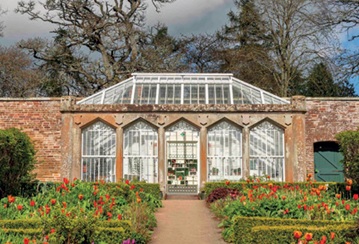Roundwood framing
Roundwood framing is one of the oldest forms of timber construction, the timber is used 'in the round' that is to say in full circular lengths with little or no processing or slicing.
[edit] Advantages and disadvantages
Some of the advantages of using roundwood for construction might be:
A reduction in material waste. Standard squared timber comes from roundwood logs, and as such, edges are lost in the milling and slicing process, although these offcuts are often used for other purposes such as papermaking or as fuel.
The milling processes themselves rely on vast amounts of energy for transportation and processing to create square-diameter timbers. The reduced processing required by round wood improves these efficiencies.
Strength. Because round wood timbers are used as they have grown in full rings, their structure inherently has greater strength, with reduced twisting and deformity. Because of this smaller section, timbers can be used for basic framing, thus replacing younger trees and speeding up the cycle from planting to harvesting.
Reduced ground disturbance: in some cases where coppice wood is used, timbers can be cut from higher up a tree, this allows the wood to be harvested without cutting the tree down completely, allowing it to grow back. This also allows timber to be harvested without disturbing the tree roots and soil, which is where the majority of carbon from its growth is stored.
Some of the disadvantages might be that it is less common and not readily available; it requires some specialist knowledge in terms of jointing the material; and when smaller timbers are used,d it can be more complex to create larger spans.
Early history
Some of the earliest forms of basic shelter would have been made from natural materials such as reeds, leaves, grass, or bark laid over a simple roundwood frame of full branches. While early humans may have been nomadic, the frames could have been clad with animal skins and bound with natural reeds, often triangular and easy to erect and disassemble, commonly referred to as an early form of yurt.
The first recordings of a yurt were made by Herodotus of Halicarnassus, who described yurt-like tents as the dwelling place of the Scythians, a horse-riding nomadic nation who lived in the northern Black Sea and Central Asian region from around 600 BC. Simple braced-frame structures or reed hut shelters can still be found today in places like Sudan and Iraq, while yurts can be seen in Central Asia.
In Ethiopia, in the late 1800's, as timber stocks around Addis Ababa ran bare due to use as building material and fuel for a growing population, the king at the time planted Blue Eucalyptus due to its ability to grow quickly and regrow from stumps (early coppice wood). The Tukul or Sarbet grass house thus became a common round wood skeletal form of shelter, made with coppice round wood, with a triangular roof sitting on a circular structure of timber and reed that was then plastered in clay and earth. Many other examples of these simple timber-round wood structures forming the basis of shelter, tents, and hybrid earth structures exist around the world. Examples can be found in the excellent pictorial essay book 'Shelter', first published in 1973 by Shelter publications.
Examples today
Round wood and timber structures remain popular with self-builders and some architects. One place where a number of different roundwood experimental buildings can be found is Hooke Park, Dorset. Hooke Park is the Architectural Association's woodland campus and contains a growing educational facility for design, workshop, construction, and landscape-focused activities. The site is home to the Design + Make postgraduate masters programme, sees visits from AA units and programmes, and hosts numerous short courses, lectures, and events throughout the year. Projects are supported by a diverse team of expert practitioners, including craftspeople, designers, engineers, roboteers, a forester, and more, in an environment that combines a forest, studio, workshop, and building site. The site contains roundwood buildings designed and constructed by the likes of Edward, known as 'Ted' Cullinan, and the engineer Edmund, also known as 'Ted' Happold.
The articles Patterns 8 and Patterns 12 on the Designing Buildings wiki by Buro Happold engineers describes and details some of these round wood examples.
[edit] Related articles on Designing Buildings
- Bodger
- A history of timber framing.
- Beech coppice.
- Best Woods for Wood Carving.
- Bodger.
- Carpentry.
- Chip carving.
- Natural building.
- Physical Properties of Wood.
- The Art of Pyrography.
- Timber.
- The history and techniques of woodturning.
- The Differences Between Hardwood and Softwood
- Timber species
- Types of rapidly renewable content.
[edit] External Links
https://hookepark.aaschool.ac.uk/
Featured articles and news
Ebenezer Howard: inventor of the garden city. Book review.
The Grenfell Tower fire, eight years on
A time to pause and reflect as Dubai tower block fire reported just before anniversary.
Airtightness Topic Guide BSRIA TG 27/2025
Explaining the basics of airtightness, what it is, why it's important, when it's required and how it's carried out.
Construction contract awards hit lowest point of 2025
Plummeting for second consecutive month, intensifying concerns for housing and infrastructure goals.
Understanding Mental Health in the Built Environment 2025
Examining the state of mental health in construction, shedding light on levels of stress, anxiety and depression.
The benefits of engaging with insulation manufacturers
When considering ground floor constructions.
Lighting Industry endorses Blueprint for Electrification
The Lighting Industry Association fully supports the ECA Blueprint as a timely, urgent call to action.
BSRIA Sentinel Clerk of Works Training Case Study
Strengthening expertise to enhance service delivery with integrated cutting-edge industry knowledge.
Impact report from the Supply Chain Sustainability School
Free sustainability skills, training and support delivered to thousands of UK companies to help cut carbon.
The Building Safety Forum at the Installershow 2025
With speakers confirmed for 24 June as part of Building Safety Week.
The UK’s largest air pollution campaign.
Future Homes Standard, now includes solar, but what else?
Will the new standard, due to in the Autumn, go far enough in terms of performance ?
BSRIA Briefing: Cleaner Air, Better tomorrow
A look back at issues relating to inside and outside air quality, discussed during the BSRIA briefing in 2023.
Restoring Abbotsford's hothouse
Bringing the writer Walter Scott's garden to life.
Reflections on the spending review with CIAT.
Retired firefighter cycles world to raise Grenfell funds
Leaving on 14 June 2025 Stephen will raise money for youth and schools through the Grenfell Foundation.
Key points for construction at a glance with industry reactions.






















